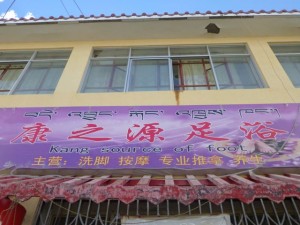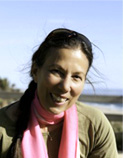The farther west we go in Tibet, the more arid and high the country becomes. We are now routinely at over 4500 meters. The air is thin and dry; I breathe it in great gulps, and still don’t quite feel that I’ve gotten a satisfying deep breath. The sky is a blue so bright I squint behind the polarized lenses of my RayBans.
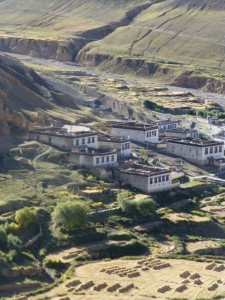
In the folds of rolling ochre hills, shepherds pasture their yak herds, moving slowly lower as the snows of winter encroach. The grass is as sparse as day-old stubble, yet the yaks look robust, more so than the children of the shepherds, who are thin and ragged, a six-year-old looking like a four-year-old. Small sheep and goats also populate these hills, which in a state like Colorado would overtop even the highest fourteener. Here, the snow covered peaks only begin around twenty thousand feet.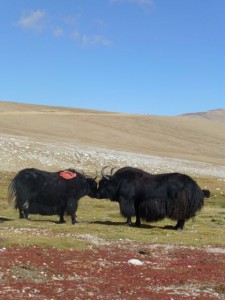
The yaks, mostly black though there’s an occasional beige or cream-colored one, sport long wooly skirts. They don’t hesitate to issue a grumbling cough and flick their long bushy tails at us when we come too close.
We’ve gone from the golden stubble of barley fields being harvested on the plains below Everest, to the mighty west face of Everest itself, rising clear and grand from Rongbuk glacier into the rays of a brilliant white full moon. 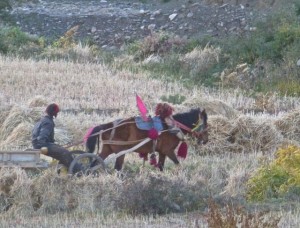
A rugged drive over roads carpeted with jagged rocks took us through the above-mentioned alpage, then along a ribbon of highway empty of cars except us and the occasional other tourist Land Cruisers, all of them filled with Chinese tourists.

This year the Chinese government issued only 10% of Tibet visas to westerners, so we feel especially lucky to be here. In fact, the stated goal of the government is to dilute the native Tibetan population to 50% of inhabitants of the Tibet Autonomous Region, by 2018. Chinese are encouraged to travel here in hopes they will return permanently, open businesses (it’s tax-free for them), and partake in achieving that goal.
The central Tibetan towns are dusty and bedraggled, crumbling sidewalks lined with 10×12 stalls that serve as restaurants or mini-marts selling toothpaste, cookies and sweet drinks. One town, Saga, was in the midst of city-wide infrastructure ‘improvement.’ The rich steam from packets of Nescafe dumped into hot water could not displace the odor of raw sewage from the open trench that ran in front. Happiness comes when one of us spies a box of Snickers for sale, which in my experience is the best treat one can have on these trips, where everything is so foreign in smell, taste and sound.
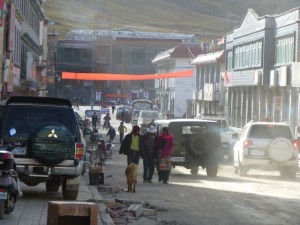
Our breakfasts are sparse, featuring a hardboiled egg if we’re lucky, and perhaps a chapati-like flatbread favored by Tibetans. I haven’t yet screwed up my courage to sample the typical Tibetan breakfast, which is made of tsampa (barley flour) mixed with yak butter. But I will, I swear…..
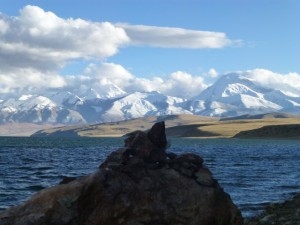
One glorious afternoon we hiked up to a viewpoint below Mt. Kailash, the sacred mountain of Buddhists which is also the source of the headwaters of the Indus, the Sutlej and the Brahmaputra rivers. Prayer flags flapped in the strong wind and a faraway monastery pulled a disappearing act behind the foothills as we walked upward to a flag-draped promontory at 5,075 meters.
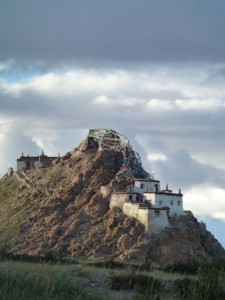
Below, pilgrims and devotees followed the broad path around Kailash’s circumference, some prostrating themselves at designated prayer stations, observed by thick-coated black village dogs, descendants perhaps of the huge Tibetan mastiff.
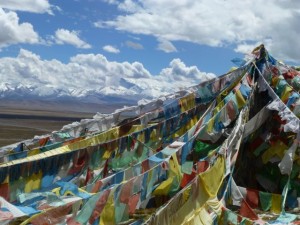
We have just reached the western-most point in our journey, the town of Toling/Zanda (most towns have both a Chinese and a Tibetan name). It is lovely here, as we are back down below tree level, with poplars turning yellow and the Sutlej river running pearl blue toward India. A twisting road through wrinkled cliffs of beige sandstone took us up to snow level before depositing us in this fertile valley.
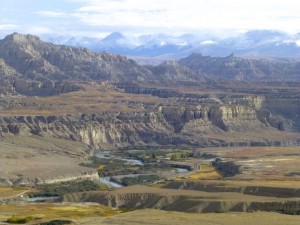
The town itself is cleaner and quieter than any other we’ve been through, making it actually pleasant to stroll down the street. 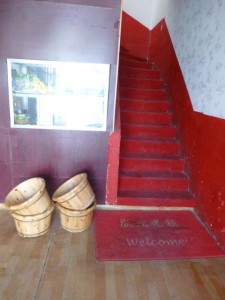 It is in that way that I discovered the local foot massage parlor, up a red-carpeted flight of stairs, in a bright clean room with windows shielded by yellow flowered curtains. There I spent a blissful hour and a half with my feet soaking in an oak tub filled with hot water and an herbaceous concoction of Chinese herbs, my back and limbs being pounded, pulled and jabbed like the lump of dough I feel I’ve become, followed eventually by an excruciating excavation of every knot and hard spot on the soles of my feet. Heaven!
It is in that way that I discovered the local foot massage parlor, up a red-carpeted flight of stairs, in a bright clean room with windows shielded by yellow flowered curtains. There I spent a blissful hour and a half with my feet soaking in an oak tub filled with hot water and an herbaceous concoction of Chinese herbs, my back and limbs being pounded, pulled and jabbed like the lump of dough I feel I’ve become, followed eventually by an excruciating excavation of every knot and hard spot on the soles of my feet. Heaven!